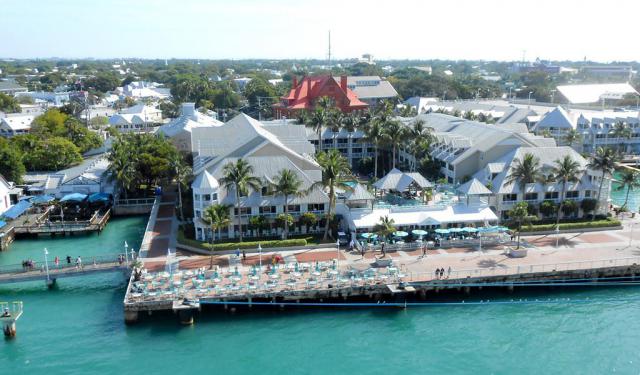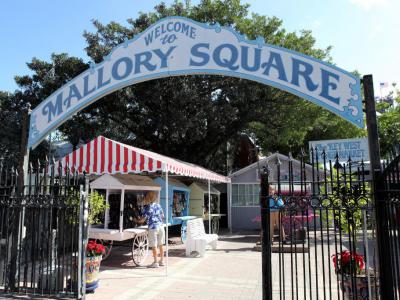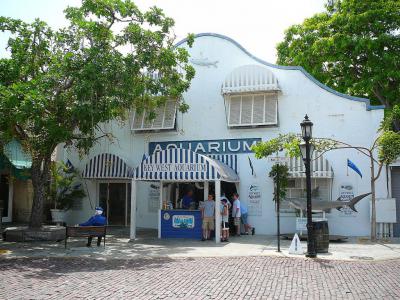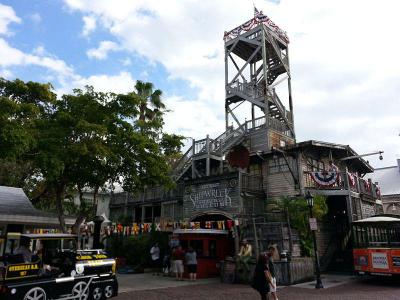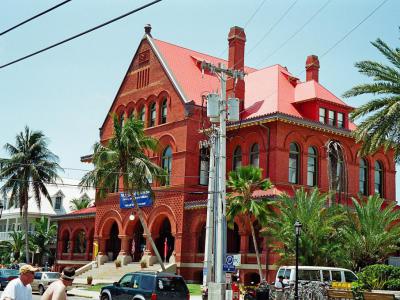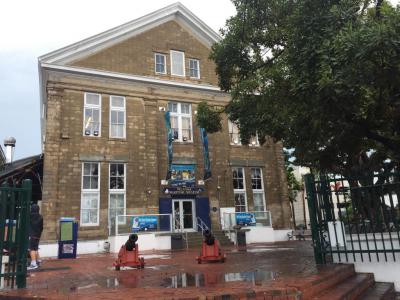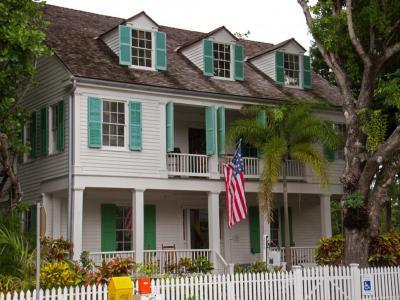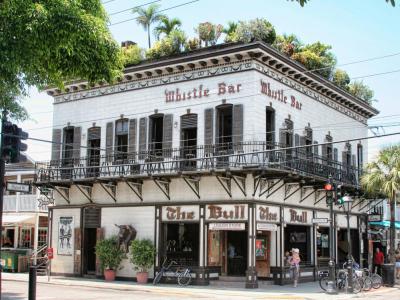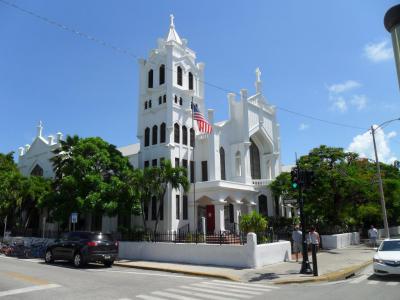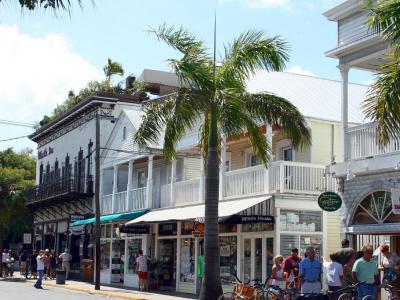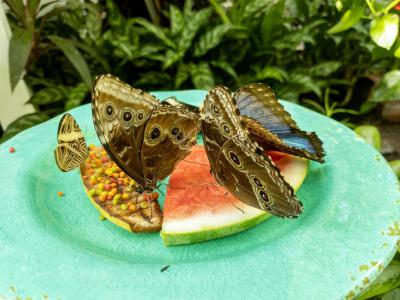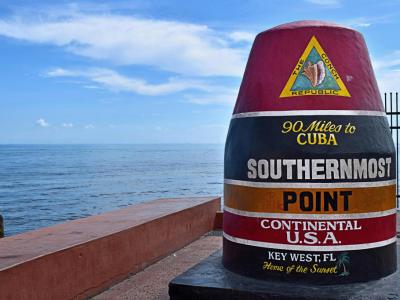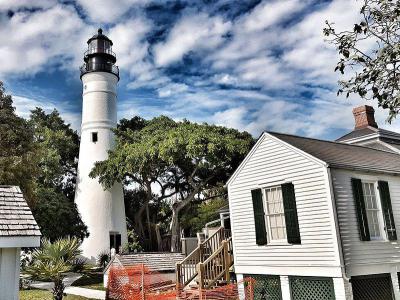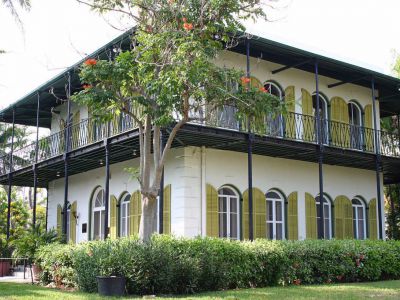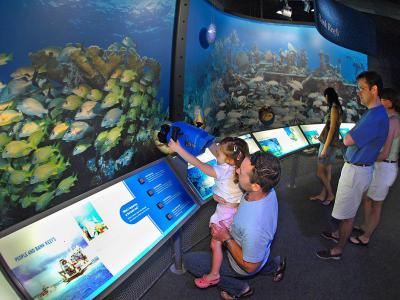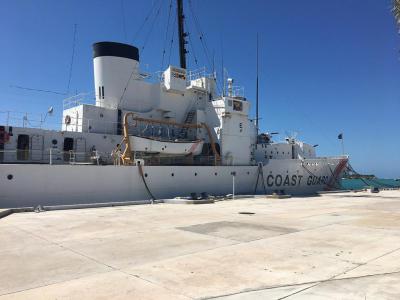Key West Introduction Walking Tour (Self Guided), Key West
For the historically curious as well as for party-goers or laid-back drifters, Key West is a small paradise at the end of U.S. Route 1, on the southernmost tip of the continental United States, in the Florida Keys archipelago. The installed here Southernmost Point landmark reminds of this fact and is a popular spot for photos and selfies.
Key West is blessed with beautiful nature, indeed. Here, the gorgeous sunsets are richly complemented by endless white sandy beaches, aquamarine-tinted sea, clear weather, and pastel-colored historical buildings.
The area of Key West was originally inhabited by the Calusa Native Americans until the arrival of Spanish explorers in the 16th century. It was later occupied by the British during the American Revolution, and then by the Spanish again until the United States purchased Florida from Spain in 1819.
In 1822, the U.S. established a naval base in Key West, to combat piracy in the Caribbean, and thus prompted the town's rapid development. The local lighthouse built around that time is now a museum.
During the early 20th century, the town attracted many artists and writers, including Ernest Hemingway, who made it his home, between 1931 and 1939. “I want to get to Key West and get away from it all,” he used to say. The historic residence of the famous American author today serves as a museum showcasing his personal belongings and memorabilia.
Present-day Key West is a thriving tourist mecca known for its vibrant nightlife, boosted in large part by the cruise ships laden with folk seeking “high tides and Key West vibes”. The lively Duval Street is the main commercial and entertainment district, luring both tourists and locals in their numbers. Another popular gathering spot – Mallory Square – is the waterfront plaza to watch sunsets, enjoy live music, and browse the many street vendors and performers.
They say, those on Key time don’t wear watches, and that once gone to Key West you are never fully back again. One thing for certain is that many, if not all good stories start in Key West. You can have yours, too. But remember, you may leave the Keys, but the Keys never leave you!
Key West is blessed with beautiful nature, indeed. Here, the gorgeous sunsets are richly complemented by endless white sandy beaches, aquamarine-tinted sea, clear weather, and pastel-colored historical buildings.
The area of Key West was originally inhabited by the Calusa Native Americans until the arrival of Spanish explorers in the 16th century. It was later occupied by the British during the American Revolution, and then by the Spanish again until the United States purchased Florida from Spain in 1819.
In 1822, the U.S. established a naval base in Key West, to combat piracy in the Caribbean, and thus prompted the town's rapid development. The local lighthouse built around that time is now a museum.
During the early 20th century, the town attracted many artists and writers, including Ernest Hemingway, who made it his home, between 1931 and 1939. “I want to get to Key West and get away from it all,” he used to say. The historic residence of the famous American author today serves as a museum showcasing his personal belongings and memorabilia.
Present-day Key West is a thriving tourist mecca known for its vibrant nightlife, boosted in large part by the cruise ships laden with folk seeking “high tides and Key West vibes”. The lively Duval Street is the main commercial and entertainment district, luring both tourists and locals in their numbers. Another popular gathering spot – Mallory Square – is the waterfront plaza to watch sunsets, enjoy live music, and browse the many street vendors and performers.
They say, those on Key time don’t wear watches, and that once gone to Key West you are never fully back again. One thing for certain is that many, if not all good stories start in Key West. You can have yours, too. But remember, you may leave the Keys, but the Keys never leave you!
How it works: Download the app "GPSmyCity: Walks in 1K+ Cities" from Apple App Store or Google Play Store to your mobile phone or tablet. The app turns your mobile device into a personal tour guide and its built-in GPS navigation functions guide you from one tour stop to next. The app works offline, so no data plan is needed when traveling abroad.
Key West Introduction Walking Tour Map
Guide Name: Key West Introduction Walking Tour
Guide Location: USA » Key West (See other walking tours in Key West)
Guide Type: Self-guided Walking Tour (Sightseeing)
# of Attractions: 16
Tour Duration: 3 Hour(s)
Travel Distance: 4.0 Km or 2.5 Miles
Author: DanaOffice
Sight(s) Featured in This Guide:
Guide Location: USA » Key West (See other walking tours in Key West)
Guide Type: Self-guided Walking Tour (Sightseeing)
# of Attractions: 16
Tour Duration: 3 Hour(s)
Travel Distance: 4.0 Km or 2.5 Miles
Author: DanaOffice
Sight(s) Featured in This Guide:
- Mallory Square
- Key West Aquarium
- Key West Shipwreck Treasure Museum
- Key West Museum of Art & History
- Mel Fisher Maritime Museum
- Audubon House & Tropical Gardens
- Harry S. Truman Little White House
- Bull and Whistle Bar
- St. Paul's Episcopal Church
- Duval Street
- Key West Butterfly & Nature Conservatory
- The Southernmost Point
- Key West Lighthouse & Museum
- Ernest Hemingway Home & Museum
- Florida Keys Eco-Discovery Center
- U.S. Coast Guard Cutter Ingham Maritime Museum
1) Mallory Square (must see)
Fronting on the world-famous Sunset Pier in the heart of Old Town Key West, Mallory Square is known for its stunning sunsets, street shows, and lively atmosphere.
The square is named after Stephen Russell Mallory, a U.S. Senator and Secretary of the Navy for the Confederacy during the American Civil War. In the early 1800s, it was used as a naval base for the U.S. Navy and, later, as a commercial port, with ships bringing goods from the Caribbean and other parts of the world. During much of the 19th century, Key West was a hub for the salvaging of shipwrecks; many of the recovered items were sold in Mallory Square.
The tradition of celebrating the sunset began here in the 1960s. Local artists and performers would gather in the evening to marvel at the sun going down over the water, and eventually, crowds began to form and join in on the festivities.
Street performers – such as fire eaters, jugglers, musicians, and other wacky tricksters – are a standalone attraction at Mallory. To perform in the square they must audition and be licensed by the city. The performers range from a one-man band and fire jugglers to world-famous Kwinci, who swallows a 40-inch balloon and walks barefoot on broken glass (you have to see this to believe it).
Then there's Warren Lee, the Sophisticated Swindler. No trip to Key West is complete without seeing Dominique and his Flying House Cats. Somehow, he has trained his cats to jump through hoops of fire and other, very un-cat-like tricks.
In 2017, Mallory Square was severely damaged by Hurricane Irma. However, it was quickly rebuilt and today remains as vibrant and popular a destination as ever.
Why You Should Visit:
People-watching at this popular location is quite fun, as you have all kinds of walks of life here. The breeze is usually pretty refreshing even on hotter and humid days due to the oceanfront location.
Tip:
Bring cash and if you stop to watch, tip the performers – they deserve it. Surrounding are many delightful shops and craftsmen selling their wares, and you can get some nice food and drinks, all coupled with the spectacular view of the sun sinking into the Gulf of Mexico – a photographer's delight.
The square is named after Stephen Russell Mallory, a U.S. Senator and Secretary of the Navy for the Confederacy during the American Civil War. In the early 1800s, it was used as a naval base for the U.S. Navy and, later, as a commercial port, with ships bringing goods from the Caribbean and other parts of the world. During much of the 19th century, Key West was a hub for the salvaging of shipwrecks; many of the recovered items were sold in Mallory Square.
The tradition of celebrating the sunset began here in the 1960s. Local artists and performers would gather in the evening to marvel at the sun going down over the water, and eventually, crowds began to form and join in on the festivities.
Street performers – such as fire eaters, jugglers, musicians, and other wacky tricksters – are a standalone attraction at Mallory. To perform in the square they must audition and be licensed by the city. The performers range from a one-man band and fire jugglers to world-famous Kwinci, who swallows a 40-inch balloon and walks barefoot on broken glass (you have to see this to believe it).
Then there's Warren Lee, the Sophisticated Swindler. No trip to Key West is complete without seeing Dominique and his Flying House Cats. Somehow, he has trained his cats to jump through hoops of fire and other, very un-cat-like tricks.
In 2017, Mallory Square was severely damaged by Hurricane Irma. However, it was quickly rebuilt and today remains as vibrant and popular a destination as ever.
Why You Should Visit:
People-watching at this popular location is quite fun, as you have all kinds of walks of life here. The breeze is usually pretty refreshing even on hotter and humid days due to the oceanfront location.
Tip:
Bring cash and if you stop to watch, tip the performers – they deserve it. Surrounding are many delightful shops and craftsmen selling their wares, and you can get some nice food and drinks, all coupled with the spectacular view of the sun sinking into the Gulf of Mexico – a photographer's delight.
2) Key West Aquarium (must see)
Located in famous Mallory Square, the Key West Aquarium is one of the oldest aquariums in Florida – built between 1932 and 1934. It also claims to be the first tourist site in the Keys, attracting first-time visitors with its uniqueness.
Originally open-air (one of the first and largest at the time), the aquarium is now home to a variety of marine life, including sea turtles, sharks, stingrays, and tropical fish. It offers interactive experiences, such as touch tanks where visitors can touch and learn about various ocean animals. There are also daily feedings and guided tours that offer educational information about the marine species on display.
One of the most popular exhibits at the aquarium is the shark tank, which contains several species of sharks, including nurse sharks, blacktip sharks, and lemon sharks. Visitors can watch the sharks being fed and learn about their behavior and habitat. The aquarium also has a sea turtle exhibit, where visitors can observe sea turtles up close and learn about their conservation efforts.
The Key West Aquarium is open daily throughout the year; the tickets can be purchased on-site or online. Some people complain about the price, but put this on your list if you prefer aquariums where you can take time looking at each exhibit rather than fighting off crowds for just a peek. The ticket is good for two days and you can go in and out as much as you want.
Why You Should Visit:
The shark feeding is something to see – giant sharks thrash around during feeding time in the outdoor pens and tiny colorful reef fish flit about in small tanks lining the walls inside.
Note some really interesting murals of the local history in a very quaint space.
Tours aren't crowded; you can easily hear what's being said and there is enough breathing room around if you seek to avoid the heat of the day.
Tip:
Check the feeding schedule to take advantage of the full experience.
Originally open-air (one of the first and largest at the time), the aquarium is now home to a variety of marine life, including sea turtles, sharks, stingrays, and tropical fish. It offers interactive experiences, such as touch tanks where visitors can touch and learn about various ocean animals. There are also daily feedings and guided tours that offer educational information about the marine species on display.
One of the most popular exhibits at the aquarium is the shark tank, which contains several species of sharks, including nurse sharks, blacktip sharks, and lemon sharks. Visitors can watch the sharks being fed and learn about their behavior and habitat. The aquarium also has a sea turtle exhibit, where visitors can observe sea turtles up close and learn about their conservation efforts.
The Key West Aquarium is open daily throughout the year; the tickets can be purchased on-site or online. Some people complain about the price, but put this on your list if you prefer aquariums where you can take time looking at each exhibit rather than fighting off crowds for just a peek. The ticket is good for two days and you can go in and out as much as you want.
Why You Should Visit:
The shark feeding is something to see – giant sharks thrash around during feeding time in the outdoor pens and tiny colorful reef fish flit about in small tanks lining the walls inside.
Note some really interesting murals of the local history in a very quaint space.
Tours aren't crowded; you can easily hear what's being said and there is enough breathing room around if you seek to avoid the heat of the day.
Tip:
Check the feeding schedule to take advantage of the full experience.
3) Key West Shipwreck Treasure Museum (must see)
The Key West Shipwreck Treasure Museum brings to life the island's fascinating maritime history by telling stories of the brave men and women who risked their lives to salvage the treasures of the many ships that wrecked off the Florida Keys.
The museum is housed in a historic building that was originally constructed in 1852 by wrecker tycoon Asa Tift as a warehouse for the island's thriving wrecking industry. The latter played a key role in Key West's economy during the 19th century and involved salvaging goods from the ships that had run aground near the island.
Over the years, the building has survived fires, hurricanes, and other natural disasters. Towards the end of the 19th century, it was used as a cigar factory and later served as a sponge warehouse. In the 1980s, the building was restored and turned into a museum. The restoration preserved many of its original features, including the distinctive walls clad in wooden siding and arched doorway.
Inside, the museum showcases historical documents and artifacts recovered from the shipwrecks, including treasures such as gold and silver bars, coins, and other valuable items. Many of them come from the 1985 rediscovery of the wrecked vessel Isaac Allerton, which sank in 1856 on the Florida Keys reef and turned out to be one the richest shipwrecks in the city's history, having resulted in the Federal Wrecking Court's largest monetary award for the salvage of a single vessel. Also displayed here are relics from Spanish galleons, including a silver bar salvaged from the Nuestra Senora de las Maravillas that visitors are encouraged to try to lift.
From the top floor, guests can also walk up the 65-foot lookout tower for a panoramic view of the harbor and most of Key West. The tower was added during the restoration of the building much later and today serves as a reminder of the vital role that such towers once played in keeping ships safe from the treacherous reefs surrounding the Florida Keys.
In addition to that, the museum offers a variety of interactive experiences, including live performers reenacting salvage operations that took place in Key West centuries ago. Visitors can also try their hand at the salvaging techniques, using some of the tools and equipment utilized by 19th-century wreckers.
Why You Should Visit:
A unique window into the rich maritime history of Florida Keys.
To learn about the many shipwrecks that made Key West one of the richest towns in the U.S.
Tip:
Taking a small flashlight, to read many of the signs and posters or labels, would be quite helpful.
You can get a great discount by buying combo tickets for other Key West museums.
The museum is housed in a historic building that was originally constructed in 1852 by wrecker tycoon Asa Tift as a warehouse for the island's thriving wrecking industry. The latter played a key role in Key West's economy during the 19th century and involved salvaging goods from the ships that had run aground near the island.
Over the years, the building has survived fires, hurricanes, and other natural disasters. Towards the end of the 19th century, it was used as a cigar factory and later served as a sponge warehouse. In the 1980s, the building was restored and turned into a museum. The restoration preserved many of its original features, including the distinctive walls clad in wooden siding and arched doorway.
Inside, the museum showcases historical documents and artifacts recovered from the shipwrecks, including treasures such as gold and silver bars, coins, and other valuable items. Many of them come from the 1985 rediscovery of the wrecked vessel Isaac Allerton, which sank in 1856 on the Florida Keys reef and turned out to be one the richest shipwrecks in the city's history, having resulted in the Federal Wrecking Court's largest monetary award for the salvage of a single vessel. Also displayed here are relics from Spanish galleons, including a silver bar salvaged from the Nuestra Senora de las Maravillas that visitors are encouraged to try to lift.
From the top floor, guests can also walk up the 65-foot lookout tower for a panoramic view of the harbor and most of Key West. The tower was added during the restoration of the building much later and today serves as a reminder of the vital role that such towers once played in keeping ships safe from the treacherous reefs surrounding the Florida Keys.
In addition to that, the museum offers a variety of interactive experiences, including live performers reenacting salvage operations that took place in Key West centuries ago. Visitors can also try their hand at the salvaging techniques, using some of the tools and equipment utilized by 19th-century wreckers.
Why You Should Visit:
A unique window into the rich maritime history of Florida Keys.
To learn about the many shipwrecks that made Key West one of the richest towns in the U.S.
Tip:
Taking a small flashlight, to read many of the signs and posters or labels, would be quite helpful.
You can get a great discount by buying combo tickets for other Key West museums.
4) Key West Museum of Art & History
The Key West Museum of Art & History, also known as the Custom House Museum, is an important part of Key West's historical scene and serves as a reminder of the city's rich architectural and cultural heritage.
The presented here exhibits include everything, from maritime artifacts to fine art, as well as items related to shipwreck salvaging, cigar manufacturing, and the island's famous literary personalities, such as Ernest Hemingway and Robert Frost, plus the works by long-ago local artists with many talents and backgrounds.
The building itself is also an important artifact and serves as an excellent example of Richardsonian Romanesque architecture, much popular in the late 19th century. It was constructed in 1891 to a design by William Alfred Freret who used for its construction red bricks brought from New York, iron from Pennsylvania, and workers from all over the United States.
Over the years, the building has served various functions, including a courthouse and customhouse (responsible for collecting import duties and enforcing maritime laws), until 1932, and then as a post office, until 1972. In the late 1970s, it was slated for demolition, but a group of concerned citizens formed the Key West Art & Historical Society and worked to save the building and turn it into a museum. The latter officially opened to the public in 1991.
On off-weather days, this museum is a great place to visit for the terrific artwork on display, as well as for the wonderful educational boards and artifacts to delight both history buffs and a more general audience. An affordable, comprehensive, and air-conditioned experience.
Tip:
Be sure to make time for the gift shop – a gold mine of top-quality items at reasonable prices; not exactly what one would expect in a beach town. Books by local authors, art, fun decor pieces, jewelry... So many pretty things!
The presented here exhibits include everything, from maritime artifacts to fine art, as well as items related to shipwreck salvaging, cigar manufacturing, and the island's famous literary personalities, such as Ernest Hemingway and Robert Frost, plus the works by long-ago local artists with many talents and backgrounds.
The building itself is also an important artifact and serves as an excellent example of Richardsonian Romanesque architecture, much popular in the late 19th century. It was constructed in 1891 to a design by William Alfred Freret who used for its construction red bricks brought from New York, iron from Pennsylvania, and workers from all over the United States.
Over the years, the building has served various functions, including a courthouse and customhouse (responsible for collecting import duties and enforcing maritime laws), until 1932, and then as a post office, until 1972. In the late 1970s, it was slated for demolition, but a group of concerned citizens formed the Key West Art & Historical Society and worked to save the building and turn it into a museum. The latter officially opened to the public in 1991.
On off-weather days, this museum is a great place to visit for the terrific artwork on display, as well as for the wonderful educational boards and artifacts to delight both history buffs and a more general audience. An affordable, comprehensive, and air-conditioned experience.
Tip:
Be sure to make time for the gift shop – a gold mine of top-quality items at reasonable prices; not exactly what one would expect in a beach town. Books by local authors, art, fun decor pieces, jewelry... So many pretty things!
5) Mel Fisher Maritime Museum (must see)
The story of Mel Fisher and his discovery of the Nuestra Señora de Atocha along with its treasures are near what fantasy dreams are made of and what epitomizes the cultural attitudes behind the Conch Republic – Key West's strange-but-true 1982 "secession" from the United States. In a way, the story really has it all, and when reading it and viewing the artifacts, the looting, the scheming, the treachery, the deaths and tragedies can all come to light.
This museum is exactly what it advertises and is filled with interesting finds from the 17th-century Atocha vessel: stunning jewelry, coins, part of the hull and so much more, as well information on wreckers and pirates on the upper floor. There is also a very interesting section on the slave trade and another on Cubans doing what they can to reach America – but even more important is the fully operating Conservation & Archaeology lab, where admittance is allowed during a private Lab Tour that allows touching the artifacts while learning about their various stages of conservation. Some, depending on type and density, can take anywhere from weeks to years for full conservation before being placed on display!
Tip:
Take the Conservation Lab Tour (extra fee) conducted by the extremely knowledgeable marine archaeologist who will take you through each step of the process from discovery to de-encrustation and preservation of artifacts. Plus it's really cool to be able to actually handle an encrusted artifact from a shipwreck and see all of the tools being used!
This museum is exactly what it advertises and is filled with interesting finds from the 17th-century Atocha vessel: stunning jewelry, coins, part of the hull and so much more, as well information on wreckers and pirates on the upper floor. There is also a very interesting section on the slave trade and another on Cubans doing what they can to reach America – but even more important is the fully operating Conservation & Archaeology lab, where admittance is allowed during a private Lab Tour that allows touching the artifacts while learning about their various stages of conservation. Some, depending on type and density, can take anywhere from weeks to years for full conservation before being placed on display!
Tip:
Take the Conservation Lab Tour (extra fee) conducted by the extremely knowledgeable marine archaeologist who will take you through each step of the process from discovery to de-encrustation and preservation of artifacts. Plus it's really cool to be able to actually handle an encrusted artifact from a shipwreck and see all of the tools being used!
6) Audubon House & Tropical Gardens
The Audubon House & Tropical Gardens is a nicely restored historic property where you can get a glimpse into the mid-19th-century life in Key West. It was built in the 1840s by Captain John Huling Geiger, Key West's first harbor pilot, who was one of the city's most prosperous citizens at the time. The residence was named after John James Audubon, the famous naturalist and ornithologist, who visited Key West in the 1830s and created some truly remarkable bird illustrations here.
It was due to this historical connection that the house, slated for demolition in 1958, was eventually saved from the wrecking ball. Instead, it was beautifully restored to its original 19th-century splendor, being the city's first restoration project, and today features a collection of original furnishings and those purchased at auctions in Europe, as well as artwork by Audubon displayed in the adjacent gallery.
Another major highlight is the tropical gardens surrounding the house. The gardens are filled with a variety of exotic plants, including orchids, bromeliads, hybrid crotons, tropical gingers, and palms, as well as several species of birds that are native to the area. Visitors can stroll along the garden paths and take in the lush beauty of this tropical oasis. A meditation pond and scattered seating areas among the plants make it a nice shady place to relax.
Why You Should Visit:
An attraction for those interested in nature, art, botany, architecture, and photography.
The grounds are very beautiful and although a corner property, it still manages to be private and very personal.
Tip:
Don't miss the unique gift shop in the garden, stocked with items that are well above much of what you can see elsewhere.
The museum offers guided tours, as well as hosts special events, weddings, and private parties.
Make sure to also watch the video on the 3rd floor for further information.
It was due to this historical connection that the house, slated for demolition in 1958, was eventually saved from the wrecking ball. Instead, it was beautifully restored to its original 19th-century splendor, being the city's first restoration project, and today features a collection of original furnishings and those purchased at auctions in Europe, as well as artwork by Audubon displayed in the adjacent gallery.
Another major highlight is the tropical gardens surrounding the house. The gardens are filled with a variety of exotic plants, including orchids, bromeliads, hybrid crotons, tropical gingers, and palms, as well as several species of birds that are native to the area. Visitors can stroll along the garden paths and take in the lush beauty of this tropical oasis. A meditation pond and scattered seating areas among the plants make it a nice shady place to relax.
Why You Should Visit:
An attraction for those interested in nature, art, botany, architecture, and photography.
The grounds are very beautiful and although a corner property, it still manages to be private and very personal.
Tip:
Don't miss the unique gift shop in the garden, stocked with items that are well above much of what you can see elsewhere.
The museum offers guided tours, as well as hosts special events, weddings, and private parties.
Make sure to also watch the video on the 3rd floor for further information.
7) Harry S. Truman Little White House (must see)
Built in 1890 and originally waterfront, this used to be the First Officer's quarters on the submarine base naval station before turning into President Harry S. Truman's winter White House for 175 days during 11 visits. During such visits, Cabinet members and foreign officials were regular guests for fishing trips and poker games. More notably, Truman came here shortly after his 1948 re-election, on which occasion Division Street was renamed Truman Avenue in his honor.
In 1991, the house opened as a state historic site and museum. Today regular guided tours take visitors through the site, and one can enter the rooms where the Trumans lived, worked and relaxed. Items such as President's briefcase, books, telephone, and famous "The Buck Stops Here" sign are still at his desk. (The reverse of the sign says, "I'm From Missouri.")
Why You Should Visit:
Docents here are friendly and knowledgeable while the facility has all of the original furnishings for enhanced authenticity. It is also worthwhile exploring the Truman Annex area which is a beautifully landscaped part of Key West that many miss.
Tip:
Although the entry fee is rather steep, you have the option to purchase the tickets at the front and bundle them with one of the other attractions in Key West to save a few dollars (they take credit cards, too).
In 1991, the house opened as a state historic site and museum. Today regular guided tours take visitors through the site, and one can enter the rooms where the Trumans lived, worked and relaxed. Items such as President's briefcase, books, telephone, and famous "The Buck Stops Here" sign are still at his desk. (The reverse of the sign says, "I'm From Missouri.")
Why You Should Visit:
Docents here are friendly and knowledgeable while the facility has all of the original furnishings for enhanced authenticity. It is also worthwhile exploring the Truman Annex area which is a beautifully landscaped part of Key West that many miss.
Tip:
Although the entry fee is rather steep, you have the option to purchase the tickets at the front and bundle them with one of the other attractions in Key West to save a few dollars (they take credit cards, too).
8) Bull and Whistle Bar
The Bull and Whistle Bar is one of the oldest drinking establishments in the Old Town of Key West. Harking back to the seafaring days of yore, this bar is housed in a historic building from the early 1900s and has a distinct character and charm of its own.
Originally, the building served as a boarding house and later as a brothel, catering to the sailors and seamen who frequented Key West's busy port. In the 1920s, during Prohibition, it became a speakeasy and continued to operate as an underground bar for many years. During this time, the building was also used as a gambling den and a smuggler's hideout, making it a notorious spot in Key West's underworld. In the 1950s, the property was purchased by a local businessman and turned into a retail space. It remained in use as a store until the 1970s when a group of investors bought the place and converted it into a bar.
One of Bull and Whistle's unique features is its three-story layout. Each level has its own atmosphere, giving visitors a range of options, depending on their mood. The first floor – The Bull – is one of the few remaining open-air bars of Key West. This is a lively and casual space, with a long stretch of bar, table seating, and a small stage where local musicians perform nightly. Despite being open-air, they somehow managed to have hand-painted murals all around, which is quite visually stimulating.
The second floor, called The Whistle, has a more relaxed, casual atmosphere and features a large squared bar, pool tables, games, and a balcony with a great view of Duval Street, the main drag in Key West.
For those brave enough there's the third floor. Otherwise known as the Garden of Eden, this is a clothing-optional rooftop bar, which is much popular with the adventurous lot. The bar has made more than a few people blush, over the years, for when they say “clothing optional” they literally mean it. In addition to a few daring souls in their birthday suits, the Garden – described by Rolling Stone magazine as the "best-kept secret in Key West" – also gives you a bird's eye view of the island and body painting, among other things...
Apart from its unique layout, the Bull and Whistle Bar is known for its live music and entertainment. There are bands and performers playing almost every night of the week, and the atmosphere is always lively and fun. The range of drinks on offer is wide and includes local beers, craft cocktails, and frozen drinks, and there are often specials and happy hours to take advantage of.
It is always a good place to sit and pass the time sipping on a favorite beverage, enjoying live tunes, and watching people stroll by.
Originally, the building served as a boarding house and later as a brothel, catering to the sailors and seamen who frequented Key West's busy port. In the 1920s, during Prohibition, it became a speakeasy and continued to operate as an underground bar for many years. During this time, the building was also used as a gambling den and a smuggler's hideout, making it a notorious spot in Key West's underworld. In the 1950s, the property was purchased by a local businessman and turned into a retail space. It remained in use as a store until the 1970s when a group of investors bought the place and converted it into a bar.
One of Bull and Whistle's unique features is its three-story layout. Each level has its own atmosphere, giving visitors a range of options, depending on their mood. The first floor – The Bull – is one of the few remaining open-air bars of Key West. This is a lively and casual space, with a long stretch of bar, table seating, and a small stage where local musicians perform nightly. Despite being open-air, they somehow managed to have hand-painted murals all around, which is quite visually stimulating.
The second floor, called The Whistle, has a more relaxed, casual atmosphere and features a large squared bar, pool tables, games, and a balcony with a great view of Duval Street, the main drag in Key West.
For those brave enough there's the third floor. Otherwise known as the Garden of Eden, this is a clothing-optional rooftop bar, which is much popular with the adventurous lot. The bar has made more than a few people blush, over the years, for when they say “clothing optional” they literally mean it. In addition to a few daring souls in their birthday suits, the Garden – described by Rolling Stone magazine as the "best-kept secret in Key West" – also gives you a bird's eye view of the island and body painting, among other things...
Apart from its unique layout, the Bull and Whistle Bar is known for its live music and entertainment. There are bands and performers playing almost every night of the week, and the atmosphere is always lively and fun. The range of drinks on offer is wide and includes local beers, craft cocktails, and frozen drinks, and there are often specials and happy hours to take advantage of.
It is always a good place to sit and pass the time sipping on a favorite beverage, enjoying live tunes, and watching people stroll by.
9) St. Paul's Episcopal Church
You don't have to be religious to appreciate the sheer beauty of the historic church located at the corner of Duval and Eaton streets in Old Town Key West.
Founded in 1832, this is the oldest continuously operating church in the city and has played an important role in its development. During the Civil War, the building served as a hospital for Union troops and later was also used as a courthouse and a school. Famously destroyed several times by weather calamities, the temple had the first chime of bells in Florida inaugurated in 1891. The current, fourth building on the site was designed by architect William Kerr and completed in 1919.
It features the Gothic Revival style, quite popular at the turn of the 20th century, complete with its typical elements such as pointed arches, buttresses, and a steeply pitched roof. The main entrance is located on the south side of the church and is marked by a Gothic arched doorway with intricately carved stone surrounds. The church's bell tower, which rises above the entrance, is one of the most recognizable features of the building.
Inside, the church has a spacious nave with a high, vaulted ceiling and rows of wooden pews. The stained glass windows, which were created by Tiffany Studios and others, are particularly noteworthy, depicting scenes from the life of Jesus Christ and other biblical figures. The church also features a large pipe organ, which was installed in the 1920s and has been restored several times over the years.
Several notable personalities have been associated with this church, including author Ernest Hemingway, who attended services here with his second wife, Pauline Pfeiffer. Today, Saint Paul's Episcopal Church continues to be an active congregation and hosts a number of outreach programs, including a food pantry and a homeless ministry. It is also a popular venue for concerts and other cultural events.
There is no charge to get in and view the stunning stained glass windows and beautiful wooden beams on the ceiling, or catch one of the marvelous impromptu concerts held during the season on alternate Sunday afternoons. A pamphlet inside relays more about the windows as well as the church's long history.
Founded in 1832, this is the oldest continuously operating church in the city and has played an important role in its development. During the Civil War, the building served as a hospital for Union troops and later was also used as a courthouse and a school. Famously destroyed several times by weather calamities, the temple had the first chime of bells in Florida inaugurated in 1891. The current, fourth building on the site was designed by architect William Kerr and completed in 1919.
It features the Gothic Revival style, quite popular at the turn of the 20th century, complete with its typical elements such as pointed arches, buttresses, and a steeply pitched roof. The main entrance is located on the south side of the church and is marked by a Gothic arched doorway with intricately carved stone surrounds. The church's bell tower, which rises above the entrance, is one of the most recognizable features of the building.
Inside, the church has a spacious nave with a high, vaulted ceiling and rows of wooden pews. The stained glass windows, which were created by Tiffany Studios and others, are particularly noteworthy, depicting scenes from the life of Jesus Christ and other biblical figures. The church also features a large pipe organ, which was installed in the 1920s and has been restored several times over the years.
Several notable personalities have been associated with this church, including author Ernest Hemingway, who attended services here with his second wife, Pauline Pfeiffer. Today, Saint Paul's Episcopal Church continues to be an active congregation and hosts a number of outreach programs, including a food pantry and a homeless ministry. It is also a popular venue for concerts and other cultural events.
There is no charge to get in and view the stunning stained glass windows and beautiful wooden beams on the ceiling, or catch one of the marvelous impromptu concerts held during the season on alternate Sunday afternoons. A pamphlet inside relays more about the windows as well as the church's long history.
10) Duval Street (must see)
Duval Street is the most famous and most traveled street in all of Key West. Designated a "Great Street" in 2012 by the American Planning Association, it runs north-south through the entire length of the island, from the Gulf of Mexico to the Atlantic Ocean, and is the main thoroughfare of the city, renowned for its vibrant nightlife, historic buildings, and an array of unique shops and restaurants.
The street is named after William Pope Duval, the first territorial governor of Florida. It was originally a sandy path that linked Fort Zachary Taylor (in the south) to Mallory Square (in the north). As the city grew, more businesses were established on the street, and thus it became a bustling commercial hub.
In the 1800s, Duval Street was home to many of Key West's wealthiest residents. The street was lined with elegant mansions, many of which have been preserved and turned into museums or bed-and-breakfasts. During the early 20th century, it grew popular with sailors and fishermen, who frequented the numerous local eateries and watering holes.
The north (lower) end of Duval (or “wild” side) accommodates the majority of bars and tourist attractions and is where most of the carousing takes place until all hours of the night (and early morning!). The south (upper) end of Duval (the "quiet" side) houses the Southernmost Point, with a mix of early Key West Victorian mansions and bungalows dotting the neighborhood. Although it is more residential and less filled with tourists, the sidewalks still bustle with activity due to the art galleries, boutiques, inns, and bodegas lining them.
On Duval Street, you will find the famous Sloppy Joe's Bar, which used to be a favorite haunt of writer Ernest Hemingway. The street is also known for its colorful characters and street performers, such as the "Cat Man" (performing with his trained cats), and the annual Fantasy Fest celebration, a 10-day event featuring costume contests, street parties, and other festivities.
Overall, Duval Street offers a unique blend of history, culture, and entertainment, and is a must-see destination for anyone visiting Key West.
The street is named after William Pope Duval, the first territorial governor of Florida. It was originally a sandy path that linked Fort Zachary Taylor (in the south) to Mallory Square (in the north). As the city grew, more businesses were established on the street, and thus it became a bustling commercial hub.
In the 1800s, Duval Street was home to many of Key West's wealthiest residents. The street was lined with elegant mansions, many of which have been preserved and turned into museums or bed-and-breakfasts. During the early 20th century, it grew popular with sailors and fishermen, who frequented the numerous local eateries and watering holes.
The north (lower) end of Duval (or “wild” side) accommodates the majority of bars and tourist attractions and is where most of the carousing takes place until all hours of the night (and early morning!). The south (upper) end of Duval (the "quiet" side) houses the Southernmost Point, with a mix of early Key West Victorian mansions and bungalows dotting the neighborhood. Although it is more residential and less filled with tourists, the sidewalks still bustle with activity due to the art galleries, boutiques, inns, and bodegas lining them.
On Duval Street, you will find the famous Sloppy Joe's Bar, which used to be a favorite haunt of writer Ernest Hemingway. The street is also known for its colorful characters and street performers, such as the "Cat Man" (performing with his trained cats), and the annual Fantasy Fest celebration, a 10-day event featuring costume contests, street parties, and other festivities.
Overall, Duval Street offers a unique blend of history, culture, and entertainment, and is a must-see destination for anyone visiting Key West.
11) Key West Butterfly & Nature Conservatory (must see)
If you seek a unique and enchanting experience with a chance to escape into a world of natural beauty and wonder, right in the middle of a bustling city, make sure to visit the Key West Butterfly and Nature Conservatory on Duval Street. This climate-controlled, glass-enclosed space houses hundreds of live butterflies from around the world, as well as exotic birds, flowering plants, trees, and cascading waterfalls.
The conservatory was established in 2003 and covers an area of approximately 5,000 square feet. It is designed to replicate a natural rainforest environment and offers visitors an up-close (almost hands-on) experience where they can walk through and observe the butterflies as they flutter around freely, feed on nectar, and interact with each other.
The conservatory is home to over 50 species of butterflies, including the striking blue morpho, vibrant monarch, and the delicate swallowtail. You can also get a close-up view of a variety of live caterpillars feeding and developing on their host plants.
In addition to the butterflies, there is a variety of "butterfly-friendly" tropical birds, such as red-factor canaries, zebra finches, cordon-blue finches, and "button" or Chinese painted quails. The birds fly freely and sing in their natural habitat.
The on-site gift shop offers souvenirs and educational materials related to butterflies and nature conservation. Guided tours are also available for those who want to learn more about butterflies and their natural environment.
Tip:
Best to go in the morning while everything is out and moving. You will love it!
Spend as much time as you like, but be sure to follow the tour guide to get the low-down on everything in the enclosure. Alternatively, the self-guided tour has signs and descriptions explaining all of the different types of butterflies.
The conservatory was established in 2003 and covers an area of approximately 5,000 square feet. It is designed to replicate a natural rainforest environment and offers visitors an up-close (almost hands-on) experience where they can walk through and observe the butterflies as they flutter around freely, feed on nectar, and interact with each other.
The conservatory is home to over 50 species of butterflies, including the striking blue morpho, vibrant monarch, and the delicate swallowtail. You can also get a close-up view of a variety of live caterpillars feeding and developing on their host plants.
In addition to the butterflies, there is a variety of "butterfly-friendly" tropical birds, such as red-factor canaries, zebra finches, cordon-blue finches, and "button" or Chinese painted quails. The birds fly freely and sing in their natural habitat.
The on-site gift shop offers souvenirs and educational materials related to butterflies and nature conservation. Guided tours are also available for those who want to learn more about butterflies and their natural environment.
Tip:
Best to go in the morning while everything is out and moving. You will love it!
Spend as much time as you like, but be sure to follow the tour guide to get the low-down on everything in the enclosure. Alternatively, the self-guided tour has signs and descriptions explaining all of the different types of butterflies.
12) The Southernmost Point (must see)
Just a few blocks from Duval Street, at the intersection of South Street and Whitehead Street, is a painted concrete buoy – 12 feet tall and 7 feet wide. This landmark indicates the southernmost point in the continental United States, as well as the southernmost point of the island chain that makes up the Florida Keys.
Originally, the place was marked with a simple sign, which often got stolen. In response to this, by 1983, the city authorities erected the now famous concrete structure. Its location is only about 90 miles from Cuba, and the proximity of the island nation is part of what makes the Southernmost Point Buoy such an iconic symbol of Key West.
The buoy is effectively an old sewer junction that was dug up in the area and found too heavy and large to move, so they decided to paint it up to look like a buoy.
The current text on it, reading "The Conch Republic. 90 Miles to Cuba, Southernmost Point Continental U.S.A., Key West, F.L., Home of the Sunset", dates back to 2011. The phrases "90 miles to Cuba" and "Home of the Sunset" were added in 1986. Previously, the line "90 miles to Cuba" was written on a smaller sign on the fence nearby. Also next to the buoy, there was a script "America Begins" painted on a curb below the “90 miles to Cuba” sign.
The buoy paint job was done by local painter-artist Danny Acosta; the city hired him again to paint the buoy after it was damaged by Hurricane Irma in 2017.
Just a little east of the marker is a small cement structure. This is a former telegraph hut that used to house an underwater telephone cable that connected Key West to Havana in 1921.
Tip:
Considering this is a favorite spot for taking photographs, it is always crowded during the day, so be prepared to queue up for about 30-40 minutes for the photo op. If you don't like crowds, you can come early in the morning and admire the unforgettable view of the sun rising from the Atlantic.
Originally, the place was marked with a simple sign, which often got stolen. In response to this, by 1983, the city authorities erected the now famous concrete structure. Its location is only about 90 miles from Cuba, and the proximity of the island nation is part of what makes the Southernmost Point Buoy such an iconic symbol of Key West.
The buoy is effectively an old sewer junction that was dug up in the area and found too heavy and large to move, so they decided to paint it up to look like a buoy.
The current text on it, reading "The Conch Republic. 90 Miles to Cuba, Southernmost Point Continental U.S.A., Key West, F.L., Home of the Sunset", dates back to 2011. The phrases "90 miles to Cuba" and "Home of the Sunset" were added in 1986. Previously, the line "90 miles to Cuba" was written on a smaller sign on the fence nearby. Also next to the buoy, there was a script "America Begins" painted on a curb below the “90 miles to Cuba” sign.
The buoy paint job was done by local painter-artist Danny Acosta; the city hired him again to paint the buoy after it was damaged by Hurricane Irma in 2017.
Just a little east of the marker is a small cement structure. This is a former telegraph hut that used to house an underwater telephone cable that connected Key West to Havana in 1921.
Tip:
Considering this is a favorite spot for taking photographs, it is always crowded during the day, so be prepared to queue up for about 30-40 minutes for the photo op. If you don't like crowds, you can come early in the morning and admire the unforgettable view of the sun rising from the Atlantic.
13) Key West Lighthouse & Museum (must see)
The Key West Lighthouse Museum occupies the first lighthouse built in the Florida Keys. Historically, a lighthouse on this site has been since 1825. The current Key West Light tower was constructed in 1848 after its predecessor was destroyed by a hurricane. Following several modifications, it stands 73 feet tall.
During the mid-1800s, Key West was the busiest port in Florida and one of the busiest in the entire United States. The lighthouse played an important role in the history of the city, as it helped guide ships through the treacherous waters surrounding the island.
After the Coast Guard decommissioned the Key West Light in 1969, it was handed over to Monroe County, which in turn leased it to the Key West Arts and Historical Society. The latter operates the lighthouse and its associated buildings as the Key West Light House and Keeper's Quarters Museum.
If you can fend off the claustrophobia and don't mind heights, you can climb 88 tiny and constricting steps to the top of this historic building to see the old lantern and enjoy panoramic views of the entire island/key and the surrounding ocean. Along the way up, there are three small landings you can stop on and rest if you need to.
The museum features exhibits that showcase the history of the structure, the people who operated it, and the maritime history of Key West. Visitors can explore the collection of navigational tools, historical photographs, and displays about the area's shipwrecks and salvaging industry.
Also, near the tower, you can see an interesting banyan tree that seems to have been planted when the lighthouse was built.
Tip:
Climbing the stairs up might get a bit challenging if you're not in sneakers, so it might be a good idea to swap the flip-flops if you do the climb.
During the mid-1800s, Key West was the busiest port in Florida and one of the busiest in the entire United States. The lighthouse played an important role in the history of the city, as it helped guide ships through the treacherous waters surrounding the island.
After the Coast Guard decommissioned the Key West Light in 1969, it was handed over to Monroe County, which in turn leased it to the Key West Arts and Historical Society. The latter operates the lighthouse and its associated buildings as the Key West Light House and Keeper's Quarters Museum.
If you can fend off the claustrophobia and don't mind heights, you can climb 88 tiny and constricting steps to the top of this historic building to see the old lantern and enjoy panoramic views of the entire island/key and the surrounding ocean. Along the way up, there are three small landings you can stop on and rest if you need to.
The museum features exhibits that showcase the history of the structure, the people who operated it, and the maritime history of Key West. Visitors can explore the collection of navigational tools, historical photographs, and displays about the area's shipwrecks and salvaging industry.
Also, near the tower, you can see an interesting banyan tree that seems to have been planted when the lighthouse was built.
Tip:
Climbing the stairs up might get a bit challenging if you're not in sneakers, so it might be a good idea to swap the flip-flops if you do the climb.
14) Ernest Hemingway Home & Museum (must see)
The Ernest Hemingway Home & Museum in Key West is the former residence of Ernest Hemingway, in which he lived from 1931 to 1939.
Presently a National Historic Landmark, this property was built in 1851 by a marine architect and salvage wrecker, Asa Tift. The beautiful French Colonial-style building features 18-inch-thick limestone walls, a metal roof, and large wrap-around verandas. The house was originally used as a family residence and later as a boarding house, a saloon, and a storage facility before it was purchased by Ernest Hemingway and his second wife, Pauline, in 1931.
The Hemingways lived here with their two sons. After their divorce in 1940, the writer moved to Cuba and later to Idaho, while Pauline continued living in the house until her death in 1951. Following that, the property remained vacant, although its ownership, in Hemingway's name, went on until the author's suicide in July 1961. Today, it represents an important part of his legacy.
During his time in this house, Hemingway wrote some of his best-received works, such as "The Green Hills of Africa," "To Have and Have Not," "The Snows of Kilimanjaro," and "For Whom the Bell Tolls."
Visitors to the museum can take a guided tour of the grounds, which include a lush garden and a swimming pool. The house is furnished with many of Hemingway's personal belongings, including his writing desk, typewriter, and hunting trophies.
One of the most famous features of the museum is its population of some 50 six-toed cats, which are believed to be the descendants of a cat named Snowball that was given to Hemingway by a ship's captain in the 1930s. Snowball was a polydactyl cat, meaning he had six toes on each paw instead of the usual five. Hemingway was so fascinated by the cat that he soon began acquiring more polydactyl cats. He believed they brought good luck and kept them as pets.
Today, the cats are considered an important part of the venue and a popular attraction – many a visitor come here specifically to see them. The cats are well-cared for by the museum staff and have their own veterinarian come twice a week to check on them.
Why You Should Visit:
The house is terrific, the Hemingway memorabilia is great, and the guided tour comes at no extra cost; you can afford yourself the time to explore the grounds (with a small pond) on your own, too.
Tip:
They only take cash at the door, so make sure you have some.
Don't miss the sad but adorable six-toed kitty graveyard in the back.
Presently a National Historic Landmark, this property was built in 1851 by a marine architect and salvage wrecker, Asa Tift. The beautiful French Colonial-style building features 18-inch-thick limestone walls, a metal roof, and large wrap-around verandas. The house was originally used as a family residence and later as a boarding house, a saloon, and a storage facility before it was purchased by Ernest Hemingway and his second wife, Pauline, in 1931.
The Hemingways lived here with their two sons. After their divorce in 1940, the writer moved to Cuba and later to Idaho, while Pauline continued living in the house until her death in 1951. Following that, the property remained vacant, although its ownership, in Hemingway's name, went on until the author's suicide in July 1961. Today, it represents an important part of his legacy.
During his time in this house, Hemingway wrote some of his best-received works, such as "The Green Hills of Africa," "To Have and Have Not," "The Snows of Kilimanjaro," and "For Whom the Bell Tolls."
Visitors to the museum can take a guided tour of the grounds, which include a lush garden and a swimming pool. The house is furnished with many of Hemingway's personal belongings, including his writing desk, typewriter, and hunting trophies.
One of the most famous features of the museum is its population of some 50 six-toed cats, which are believed to be the descendants of a cat named Snowball that was given to Hemingway by a ship's captain in the 1930s. Snowball was a polydactyl cat, meaning he had six toes on each paw instead of the usual five. Hemingway was so fascinated by the cat that he soon began acquiring more polydactyl cats. He believed they brought good luck and kept them as pets.
Today, the cats are considered an important part of the venue and a popular attraction – many a visitor come here specifically to see them. The cats are well-cared for by the museum staff and have their own veterinarian come twice a week to check on them.
Why You Should Visit:
The house is terrific, the Hemingway memorabilia is great, and the guided tour comes at no extra cost; you can afford yourself the time to explore the grounds (with a small pond) on your own, too.
Tip:
They only take cash at the door, so make sure you have some.
Don't miss the sad but adorable six-toed kitty graveyard in the back.
15) Florida Keys Eco-Discovery Center (must see)
A free, kid-friendly museum in Key West? – Yes, indeed. The Florida Keys Eco-Discovery Center is just one such – an educational facility focused on the unique ecology and environment of the Florida Keys that offers programs and activities for visitors of all ages.
Opened in 2007 and operated by the National Oceanic and Atmospheric Administration (NOAA), the center features interactive exhibits and displays information about the diverse ecosystem of the Florida Keys, including the importance of these habitats, the animals and plants living there, and the threats they face from human activities and climate change.
Upon arriving, you enter the section that contains replicas of hammocks, mangrove forests, seagrass beds, and dunes. One of the center's key attractions is a 2,500-gallon living reef exhibit, which showcases the vibrant coral reefs found in the waters surrounding the Florida Keys. The exhibit features a variety of marine species, including colorful tropical fish, sea turtles, and even sharks. Also, there is a replica of the NOAA undersea laboratory, plus a 3D video about underwater reefs and shipwrecks.
In addition to the exhibits, the center offers guided tours, workshops, and hands-on activities that allow visitors to learn about the ecology and conservation of the Florida Keys in a fun and engaging way.
A definite stop for anyone with kids in Key West and those genuinely interested in learning more about the local ocean life!
Opened in 2007 and operated by the National Oceanic and Atmospheric Administration (NOAA), the center features interactive exhibits and displays information about the diverse ecosystem of the Florida Keys, including the importance of these habitats, the animals and plants living there, and the threats they face from human activities and climate change.
Upon arriving, you enter the section that contains replicas of hammocks, mangrove forests, seagrass beds, and dunes. One of the center's key attractions is a 2,500-gallon living reef exhibit, which showcases the vibrant coral reefs found in the waters surrounding the Florida Keys. The exhibit features a variety of marine species, including colorful tropical fish, sea turtles, and even sharks. Also, there is a replica of the NOAA undersea laboratory, plus a 3D video about underwater reefs and shipwrecks.
In addition to the exhibits, the center offers guided tours, workshops, and hands-on activities that allow visitors to learn about the ecology and conservation of the Florida Keys in a fun and engaging way.
A definite stop for anyone with kids in Key West and those genuinely interested in learning more about the local ocean life!
16) U.S. Coast Guard Cutter Ingham Maritime Museum (must see)
The U.S. Coast Guard Cutter Ingham Maritime Museum is found aboard a 327-foot-long vessel that was used by the Coast Guard for over 50 years.
The Ingham was commissioned in 1936 and served in both World War II and the Vietnam War. During its long service, the boat was involved in a number of significant events in US maritime history including allied convoys between 1941 and 1943, during which it engaged and sank the enemy submarine U-626, as well as rescue missions such as the rescue of survivors from the USS McCawley, which had been torpedoed by a Japanese submarine in 1943.
One of only two preserved Treasury-class U.S. Coast Guard Cutters and the fourth ever to be named for Treasury Secretary Samuel D. Ingham, this was the most decorated vessel in the Coast Guard fleet and the only cutter to ever be awarded two Presidential Unit Citations. The Commandant of the Coast Guard declared USCGC Ingham the National Memorial to the Coast Guardsmen killed in action in WWII and Vietnam, who are identified on a memorial plaque on the quarterdeck.
After her decommissioning in 1988, the Ingham was eventually donated to the Key West Maritime Historical Society and turned into a museum. Today, visitors to the museum can explore the ship's decks, engine room, crew quarters, and other areas, as well as several exhibits on its history and the role of the Coast Guard in protecting America's waterways.
Apart from that, Ingham is probably the best location in Key West to watch the sunset away from the crowds. On Fridays and Saturdays, they set up the bow and west-facing deck with tables, chairs, and a cash bar. Otherwise, the self-guided tour is awesomely informative, covering the cutter's service from the 1930s to the 1980s and is, as such, a must for history and military buffs.
The Ingham was commissioned in 1936 and served in both World War II and the Vietnam War. During its long service, the boat was involved in a number of significant events in US maritime history including allied convoys between 1941 and 1943, during which it engaged and sank the enemy submarine U-626, as well as rescue missions such as the rescue of survivors from the USS McCawley, which had been torpedoed by a Japanese submarine in 1943.
One of only two preserved Treasury-class U.S. Coast Guard Cutters and the fourth ever to be named for Treasury Secretary Samuel D. Ingham, this was the most decorated vessel in the Coast Guard fleet and the only cutter to ever be awarded two Presidential Unit Citations. The Commandant of the Coast Guard declared USCGC Ingham the National Memorial to the Coast Guardsmen killed in action in WWII and Vietnam, who are identified on a memorial plaque on the quarterdeck.
After her decommissioning in 1988, the Ingham was eventually donated to the Key West Maritime Historical Society and turned into a museum. Today, visitors to the museum can explore the ship's decks, engine room, crew quarters, and other areas, as well as several exhibits on its history and the role of the Coast Guard in protecting America's waterways.
Apart from that, Ingham is probably the best location in Key West to watch the sunset away from the crowds. On Fridays and Saturdays, they set up the bow and west-facing deck with tables, chairs, and a cash bar. Otherwise, the self-guided tour is awesomely informative, covering the cutter's service from the 1930s to the 1980s and is, as such, a must for history and military buffs.
Walking Tours in Key West, Florida
Create Your Own Walk in Key West
Creating your own self-guided walk in Key West is easy and fun. Choose the city attractions that you want to see and a walk route map will be created just for you. You can even set your hotel as the start point of the walk.
Key West Bar Hopping
Key West, Florida is often referred to as "an amusement park for adults fueled with alcohol" and is widely renowned for its diverse and vibrant bar scene. Blessed with a tropical climate and stunning ocean views, the city enjoys a relaxed, anything-goes attitude which after dusk transforms into lively nightlife centered around the many watering holes and clubs lining the streets of the... view more
Tour Duration: 1 Hour(s)
Travel Distance: 1.3 Km or 0.8 Miles
Tour Duration: 1 Hour(s)
Travel Distance: 1.3 Km or 0.8 Miles
Useful Travel Guides for Planning Your Trip
Top 12 Bars in Key West, Florida
Drinking is a way of life in Key West. Whether you want a perfectly poured Guinness or would rather sip frozen rum runners while watching the sun set, the Southern Most City has everything to offer. This guide will help you find the most popular bars and hidden local favorites on Duval Street and...
The Most Popular Cities
/ view all
